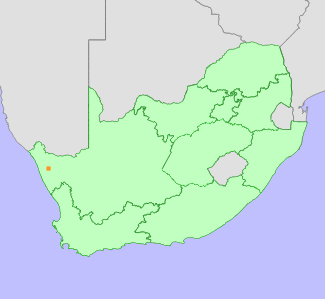|
Scientific Name | Conophytum auriflorum Tischer subsp. turbiniforme (Rawé) S.A.Hammer |
Higher Classification | Dicotyledons |
Family | AIZOACEAE |
Synonyms | Conophytum turbiniforme Rawé |
National Status |
Status and Criteria | Critically Endangered A3d; B1ab(iii)+2ab(iii) |
Assessment Date | 2021/11/18 |
Assessor(s) | A.J. Young, P.G. Desmet, I. Ebrahim, D. Guo, A. Harrower, L. Jabar, L. Knoetze, C. Rodgerson, P.C.V. Van Wyk & N.N. Mhlongo |
Justification | This succulent is endemic to the Northern Cape province of South Africa where it is only recorded from a single location with an extent of occurrence (EOO) and area of occupancy (AOO) of 8 km². The dwarf succulents that comprise this genus have been increasingly targeted by illegal collection in recent years and the vast majority of species are in high demand by collectors. Whilst there is no evidence of illegal collection at the time of this submission, closely related species, including some from the immediate area, have been illegally removed from habitat with a dramatic increase in the number of species and volume of plants targeted since 2019. The threat of illegal collection is therefore regarded as very high for this particular taxon and given its single, small, location a complete decline of the population is possible within the next 10 years.
The single location and inability to disperse also makes this succulent very susceptible to the deleterious effects of climate change. Loss of vegetation cover has been observed at this site via Landsat imagery between 1984 and 2018 and is used to infer that the habitat quality is already in decline. Anthropogenic climate change climate change is also impacting the population but there is some uncertainty of the response given the expected resilience of this taxon. This taxon qualifies as Critically Endangered under criteria A3 and B1+2. |
Distribution |
Endemism | South African endemic |
Provincial distribution | Northern Cape |
Range | This taxon is restricted to a small area of the winter rainfall region of the Northern Cape province of South Africa. |
Habitat and Ecology |
Major system | Terrestrial |
Major habitats | Namaqualand Shale Shrubland |
Description | This taxon is endemic to the Namaqualand Hardeveld bioregion of the Succulent Karoo biome. Plants occupy a niche in shaded parts of steep Nama sandstone cliffs. Plants are usually present as scattered individuals and rarely found in clusters. This succulent has a generation length of 30 years. It is expected to be sensitive to the impacts of climate change as it does not disperse and while adapted to arid conditions, is dependent on limited seasonal rainfall. Species in the genus are sensitive to long periods of drought. Drought related mortality has been observed for other closely related taxa within the genus. |
Threats |
| Species across this genus are increasingly popular in cultivation. While this particular taxon is not currently threatened by poaching it is very likely that it will likely become a target in coming years. The single location and small population size means that it is highly susceptible to illegal collection and a complete decline of up to 100% of the population is likely within 10 years.
There is an inferred decline in habitat quality for this succulent based on the loss of vegetation cover determined from changes in Enhanced Vegetation Index (EVI) between 1984 and 2018 using Landsat data (Venter et al. 2020). Anthropogenic climate change is a long-term threat to this taxon. Climate models for the likely emission scenarios where emissions stay at present day levels (RCP 2.6) (Hausfather and Peters 2020) and worst case scenarios where emissions continue to increase during the 21st century (RCP 8.5) indicate that there will be a loss of suitable bioclimatic envelope of between 73% and 100% by 2080 for this taxon. However, as this taxon occurs in a very sheltered habitat it is expected to have a level of resilience to climate change and the expected population loss is reduced by 20% to 53% based on the uncertainty of the response given the expected resilience of this taxon. Species in this genus have limited dispersal ability and migration to suitable habitats elsewhere is regarded as highly unlikely. |
Population |
This succulent occupies a niche habitat on steep vertical cliffs so it is challenging to properly estimate population size due to the inaccessibility of much of the potentially suitable habitat. There are probably 750-1,000 mature individuals. The number of plants in this general area have been in decline in recent years due to an extended drought and the population is believed to be in decline. The population is suspected to decline in the future due to illegal collection for the ornamental succulent plant trade and response to changes in climate.
|
Population trend | Unknown |
Assessment History |
Taxon assessed |
Status and Criteria |
Citation/Red List version | | Conophytum auriflorum Tischer subsp. turbiniforme (Rawé) S.A.Hammer | Critically Rare | 2017.1 | | Conophytum auriflorum Tischer subsp. turbiniforme (Rawé) S.A.Hammer | Rare | Raimondo et al. (2009) | | Conophytum auriflorum Tischer subsp. turbiniforme (Rawé) S.A.Hammer | VU D2 | Victor (2002) | |
Bibliography |
Hammer, S. 2002. Dumpling and his wife: New view of the genus Conophytum. EAE Creative Colour, Norwich.
Hammer, S.A. 1993. The genus Conophytum: A conograph. Succulent Plant Publications, Pretoria.
Hausfather, Z. and Peters, G.P. 2020. Emissions - the 'business as usual' story is misleading. Nature 577(618-620).
Opel, M.R. 2004. The rediscovery of Crassula alcicornis. Haseltonia 10:38-40.
|
Citation |
| Young, A.J., Desmet, P.G., Ebrahim, I., Guo, D., Harrower, A., Jabar, L., Knoetze, L., Rodgerson, C., Van Wyk, P.C.V. & Mhlongo, N.N. 2021. Conophytum auriflorum Tischer subsp. turbiniforme (Rawé) S.A.Hammer. National Assessment: Red List of South African Plants version 2024.1. Accessed on 2025/12/14 |
 Comment on this assessment
Comment on this assessment


